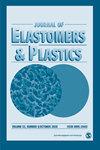植物油作为环烷油的替代品用于乳化丁苯橡胶的延伸
IF 1.6
4区 材料科学
Q4 MATERIALS SCIENCE, MULTIDISCIPLINARY
引用次数: 0
摘要
各种石油基矿物油,如蒸馏芳香提取物(DAE),处理馏出芳香提取物(TDAE),残余芳香提取物(RAE)和环烷油,用于乳液聚合丁苯橡胶(E-SBR)的延伸。从可持续性的角度来看,植物油是这些石油的替代品,因为植物油不含多环芳烃(PCA)。它们提高了耐磨性,减少了橡胶颗粒在环境中的扩散,减少了滚动阻力,从而降低了燃料消耗。然而,由于不饱和与饱和比大,引入少量植物油会导致固化反应减慢。植物油中高脂肪酸含量的存在有助于橡胶填料之间更好的相互作用。本研究采用美国材料试验学会(ASTM)标准配方,对未经任何改性的植物油(Decas, Palmolein,花生,大豆,芥末和椰子)扩展丁苯橡胶(e - sbr)进行了各种加工,不同硫化和其他性能的表征。在植物油扩展SBR的配方中调整了疗效剂的用量,使其达到环烷油模数的300%。植物油扩展乳液丁苯橡胶(E-SBR)等级(由棕榈素和椰子油制备)与环烷油扩展的SBR基化合物相比,具有相当的流变学和应力应变性能,高的增强指数(约5%),更好的橡胶-填料相互作用参数(约12%),更好的耐磨性(约23%)和相似的tanδ值在0°,30°和60°C。本文章由计算机程序翻译,如有差异,请以英文原文为准。
Use of vegetable oils as an alternate to naphthenic oil for extension of emulsion styrene butadiene rubber
Various petroleum based mineral oils like Distillate Aromatic Extract (DAE), Treated Distillate Aromatic Extract (TDAE), Residual Aromatic Extract (RAE) and Naphthenic oils are used for extension of emulsion polymerized Styrene Butadiene Rubber (E-SBR). Vegetable oils are alternate to these petroleum oil from sustainability point of view as vegetable oils have no Polycyclic Aromatic (PCA) content. They improve abrasion resistance leads to less rubber particulates spread in the environment and reduce rolling resistance leads to lower fuel consumption. However, introduction of few vegetable oils leads to slow down the cure reaction due to high unsaturation to saturation ratio. Presence of high fatty acid content in vegetable oils help in better rubber-filler interaction. In the present research, vegetable origin oils as such without any modification (Decas, Palmolein, Groundnut, Soybean, Mustard and Coconut) extended Styrene Butadiene Rubber (OE-SBR) were characterized in standard American Society for Testing and Materials (ASTM) compound recipe for various processing, different vulcanizate and other performance properties. Curative’s dosages were adjusted in the recipe of vegetable oil extended SBR’s to achieve the 300% modulus value like naphthenic oil. Vegetable oil extended Emulsion Styrene Butadiene Rubber (E-SBR) grades (Prepared with Palmolein and Coconut oils) were showing comparable rheometric and stress-strain properties, high reinforcement index (around 5%), better rubber-filler interaction parameter (around 12%), better abrasion resistance (around 23%) and comparable tanδ value @0°, 30° and 60°C as compared to naphthenic oil extended SBR based compound.
求助全文
通过发布文献求助,成功后即可免费获取论文全文。
去求助
来源期刊

Journal of Elastomers and Plastics
工程技术-材料科学:综合
CiteScore
3.30
自引率
5.90%
发文量
41
审稿时长
6 months
期刊介绍:
The Journal of Elastomers and Plastics is a high quality peer-reviewed journal which publishes original research on the development and marketing of elastomers and plastics and the area in between where the characteristics of both extremes are apparent. The journal covers: advances in chemistry, processing, properties and applications; new information on thermoplastic elastomers, reinforced elastomers, natural rubbers, blends and alloys, and fillers and additives.
 求助内容:
求助内容: 应助结果提醒方式:
应助结果提醒方式:


